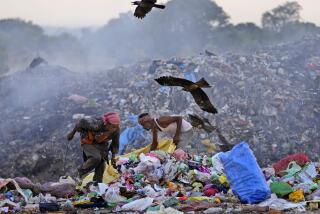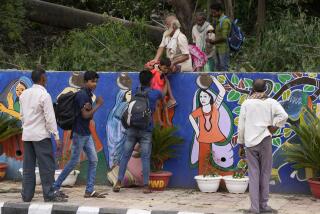India village fears being swallowed by the earth
- Share via
JHARIA, India — For nearly a century now, fires have burned beneath the ground where Mohammad Riyaz Ansari stands. At night, ghostly blue flares shoot from glowing rocks, like a terrible hell on Earth.
The 55-year-old mechanic and his neighbors here, deep in eastern India’s coal country, live above underground coal fires that are eating away at their land, India’s precious natural resources and, say some, government credibility.
As the ground subsides, thousands of houses, including Ansari’s, have sagged, collapsed or fallen into chasms over the years, including 250 destroyed over two hours in 1995.
In this eerie landscape — the plumes of flame igniting periodically as combustible gas escapes from the subterranean fires — locals speak of neighbors swallowed in their sleep. In 2006, for instance, 14-year-old Mira Kumari vanished while cooking when her house fell 50 feet underground. Her body was never recovered.
There may be many others. Activists say dozens of disappearances each year go unreported, especially those involving poor people stealing coal. “Their relatives know if they go to the police, they’ll file a case against them,” said Ashok Agarwal, head of the Save Jharia Coalfield Committee, a civic group.
Those who live in the area accuse India’s state coal company of letting the fires burn, hoping residents will leave so it can exploit the estimated $12 billion in high-grade coking coal, used in steel production, that sits below Jharia. Officials for the company, which mines the periphery of the town, say this isn’t true, but add that fully exploiting resources is needed to fuel India’s growing economy.
T.N. Singh, a retired mine safety expert with a government think tank who is now a critic, sees little likelihood that the long-standing crisis will be resolved any time soon.
“It’s not a tsunami or an explosion, so until it reaches your house, there’s little unity or urgency,” Singh said. “It’s slow death.”
About 180 families remain in the Bokapahadi neighborhood, a bleak community of grimy single-story brick houses a few inches apart, interrupted by a web of makeshift electric poles. They say they are staying, despite the health and safety risks, in hopes of a reasonable relocation package. Widespread asthma, tuberculosis and other respiratory diseases, not to mention the mental stress, are the price they pay so affluent people in New Delhi and Mumbai can enjoy their energy-guzzling lives, they say.
“We’re here out of desperation,” said Abdul Jabber, 60, a traditional Muslim healer. “Hardly anyone here lives to 65. It should be 77.”
Jharia’s fires started around 1916, possibly because abandoned mines weren’t decommissioned properly. Since then, more than 70 major fires have consumed about 41 million tons of coking coal, worth billions of dollars.
Extinguishing fires — by dousing them with sand or water, creating firebreaks or cutting off oxygen — isn’t easy. One in an isolated area of Australia has been burning 5,000 years, by some estimates. Another, in Centralia, Pa., which has burned since the 1960s, led to the relocation of 11,000 people in 1980.
Activists say the problem here is inadequate political will and an obsession with production over safety. The little people are sacrificed to corporate interests, they argue, as an energy-starved nation seeks fuel. The state coal company extinguished 10 fires around Jharia in the 1970s and ‘80s, they add, evidence that it is possible.
“It’s a criminal waste of nonrenewable resources, crony capitalism at its worst,” said Paranjoy Guha Thakurta, a journalist who made a documentary film on the area. “It’s really the story of India’s ugly underbelly.”
Starting in 1996, the government refined a $1.4-billion plan to relocate 90,000 residents of Jharia and surrounding fire-affected areas to Belgharia, a new settlement six miles away. Sixteen years later, only 1,150 families have moved amid bureaucratic inertia, construction delays and local resistance.
“At this rate, it will take them a century,” said Agarwal of the Save Jharia Coalfield Committee. “These grand planners treat people like cattle class. We’re not against relocation, but give these poor people a good deal.”
Complicating the situation, Agarwal said, are corrupt politicians and companies and the “coal mafia” here near the center of Jharkhand state, home to India’s largest coal reserves. They use the instability and weak oversight to siphon off resources, underpay royalties and hijack coal shipments.
In June, an investigation by India’s equivalent of the FBI found that sweetheart deals and other misallocation of coal resources in Jharkhand have cost the treasury $2.4 billion. Last year, an income tax raid reportedly found more than $10 million in cash in a coal contractor’s house in Jharia.
Ashoke Sarkar, a director at Bharat Coking Coal Ltd., said reports of corruption and resource misallocation are false. Relocation is complex, he added, involving various political parties and government agencies all with vested interests, although larger apartments and more roads are planned.
“It’s a big job,” he said. “Very tricky.”
Though housing units that have been provided in Belgharia, a place one advertisement called the “City of Hope,” are the same size as those people vacate — one or two rooms plus a kitchen and toilet — they’re a bumpy, hourlong drive over unpaved roads from almost all jobs, hospitals and markets.
Gita, 35, a widow with five children who declined to give her family name, said her relocation package included a small rented apartment, $200 in moving costs and a job for 18 months sorting coal at $3 a day. The rooms are small, the construction shoddy and commuting the six miles can eat up a third of her wages, she said.
“I really regret moving,” she added. “They lied, painting an overly rosy picture.”
Locals say that given the poor construction, the $17,000 allocated to move each person should be distributed directly, bypassing sticky-fingered bureaucrats.
Although the new units are better than most of the houses over the coal fields, those who haven’t yet moved still hope for a life-changing government payoff if they can just hold out long enough.
Meanwhile, a few hundred feet from Bokapahadi’s sagging houses, a massive earth mover lifts chunks of dirt into dump trucks that lumber off in clouds of dust. Strip mining has increased in recent years, justified as a way to get coal before the fire does. In fact, the method’s increased oxygen makes the coal burn faster, said Singh, the retired mine safety official.
He sees little chance the relocation standoff will end soon given the vested interests and political inaction.
“It’s already dragged on for 50 years,” he said. “Nothing’s going to be much different.”
As evening approached, Ansari and his neighbors gathered in the one-room house of teacher Rajiv Rankin, 28. About 30 feet from the glowing rocks, Hindus and Muslims mixed seamlessly in shared misery between walls painted a garish green, illuminated by a single fluorescent bulb.
Ansari said he just wants a house the earth won’t take away, a community that isn’t torn apart and access to the only town he’s ever lived in.
After his house collapsed in 2010, the family moved into an adjacent building that shares the only remaining wall of his old home. He sought compensation but was told he’d have to pay $200 to verify the claim, a fortune given his subsistence wages, especially since he was unsure if he’d even get compensation.
“Who knows how long before that house goes too,” he said. “It makes me so angry.”
As a hot breeze bearing the sulfurous smell of rotten eggs wafted past, retired driver M.D. Lukman, 64, found a tiny silver lining in this bleak landscape.
“It’s hard to see beauty in this place,” he said. “One thing, though, the flames flicker and dance at night.”
Tanvi Sharma of The Times’ New Delhi bureau contributed to this report.
More to Read
Sign up for Essential California
The most important California stories and recommendations in your inbox every morning.
You may occasionally receive promotional content from the Los Angeles Times.










